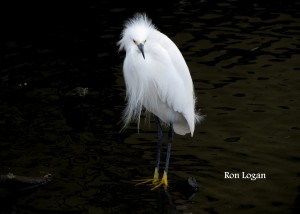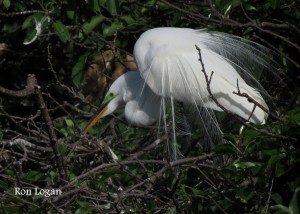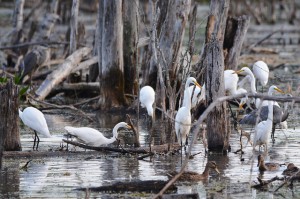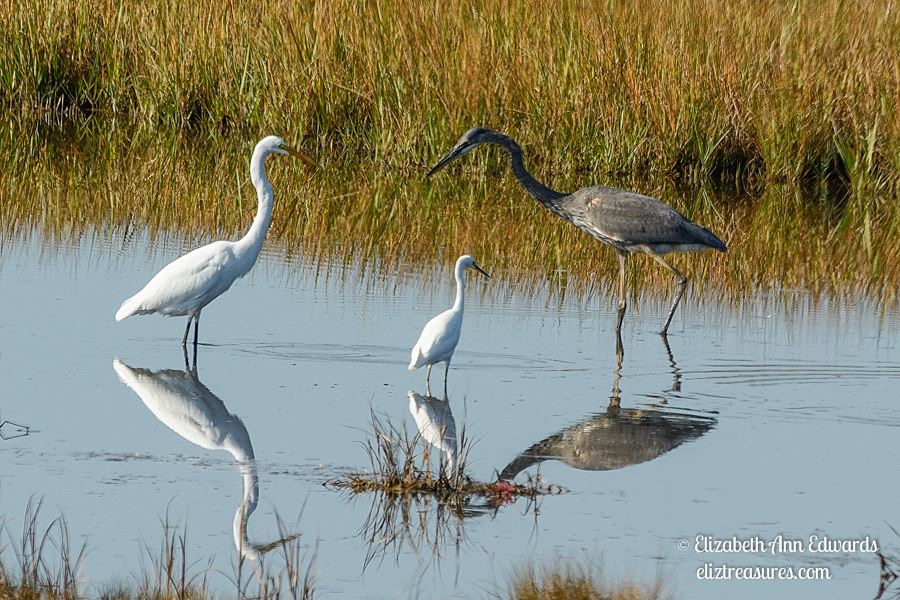December 24, 2015 at 7:44 am
[caption id="attachment_1334" align="alignleft" width="300"] A Snowy Egret sporting its plumes which were once more valuable than gold. Note its yellow feet. Photo by Ron Logan, taken in Florida.[/caption]
It’s the end of December and our colonial wading birds have flown the coop for warmer locales. Can’t blame them, can you? Despite their absence at this time of year, now is when I think of two species in particular: the Great Egret and the Snowy Egret, and it’s not because their feathers are as white as snow. It was the near extinction of these egrets that sparked the formation of the National Audubon Society as well as the first annual Christmas Bird Count.
In the latter half of the nineteenth century, it was extremely fashionable for women to accessorize their hair, hats and dresses with “aigrettes,” or bird feathers. It is no coincidence that “aigrette” is also the French word for egret because both the Snowy Egret and Great Egret suffered the greatest losses due to this fashion trend. They were in such high demand that they began to disappear. One ounce of egret plumes was worth $32, which was twice the price of gold at that time. It required four adult egrets (at the height of breeding) to produce an ounce of plumes. When you factor in that each adult killed also meant a loss of 2 or 3 eggs or young, it is no wonder these birds came so close to extinction.
Concern over the slaughter of millions of waterbirds for the millinery trade led the way for change and some of the earliest conservation actions for birds in the United States. In 1886, the Massachusetts Audubon Society was founded, and soon other states had their own Audubon organizations, all of which eventually joined forces as the National Audubon Society (NAS). In 1900, Audubon member, Frank Chapman, proposed the first annual Christmas Bird Census as an alternative to the traditional Christmas Side Hunt, a competition to see who could bring back the biggest pile of dead birds and animals. Chapman’s census would count birds during the holidays rather than kill them. In the next few decades, several laws were passed to enable these species to recover and eventually thrive again.
[caption id="attachment_1332" align="alignleft" width="300"]
A Snowy Egret sporting its plumes which were once more valuable than gold. Note its yellow feet. Photo by Ron Logan, taken in Florida.[/caption]
It’s the end of December and our colonial wading birds have flown the coop for warmer locales. Can’t blame them, can you? Despite their absence at this time of year, now is when I think of two species in particular: the Great Egret and the Snowy Egret, and it’s not because their feathers are as white as snow. It was the near extinction of these egrets that sparked the formation of the National Audubon Society as well as the first annual Christmas Bird Count.
In the latter half of the nineteenth century, it was extremely fashionable for women to accessorize their hair, hats and dresses with “aigrettes,” or bird feathers. It is no coincidence that “aigrette” is also the French word for egret because both the Snowy Egret and Great Egret suffered the greatest losses due to this fashion trend. They were in such high demand that they began to disappear. One ounce of egret plumes was worth $32, which was twice the price of gold at that time. It required four adult egrets (at the height of breeding) to produce an ounce of plumes. When you factor in that each adult killed also meant a loss of 2 or 3 eggs or young, it is no wonder these birds came so close to extinction.
Concern over the slaughter of millions of waterbirds for the millinery trade led the way for change and some of the earliest conservation actions for birds in the United States. In 1886, the Massachusetts Audubon Society was founded, and soon other states had their own Audubon organizations, all of which eventually joined forces as the National Audubon Society (NAS). In 1900, Audubon member, Frank Chapman, proposed the first annual Christmas Bird Census as an alternative to the traditional Christmas Side Hunt, a competition to see who could bring back the biggest pile of dead birds and animals. Chapman’s census would count birds during the holidays rather than kill them. In the next few decades, several laws were passed to enable these species to recover and eventually thrive again.
[caption id="attachment_1332" align="alignleft" width="300"] A Great Egret at the height of breeding. Notice its long, lacy plumes off the back and its lime-green lores. Photo by Ron Logan, taken in Florida.[/caption]
The Great Egret symbolizes the very beginnings of modern day bird conservation and is fittingly the logo of NAS. These birds have recovered and by the early 1970s, Snowy Egrets had expanded into Maine, with Great Egrets to follow about 20 years later. As far as we know, both species only nest on a few of our coastal islands and only in the southern part of the state. We estimate there are about 100 pairs of Snowy Egrets and 40 pairs of Great Egrets nesting in Maine each spring. Because they are considered to be part of recently expanding populations, they do not warrant protection under the Maine Endangered Species Act like the long-term resident Black-Crowned Night-Heron does.
Egret colonies may contain other wading birds such as the Great Blue Heron (Maine Species of Special Concern) or the Black-crowned Night-heron (State Endangered), thus we do take note of their nesting locations and keep track of their numbers. But, a sighting of a Great or Snowy Egret somewhere in the state does not necessarily indicate nearby nesting, especially when seen in the fall. After colonial wading birds breed they typically disperse in all directions before heading south for the winter. In the scientific literature, this is dubbed “nondirectional wandering.” This is why we saw at least a dozen Great Egrets at the Essex Woods marsh in Bangor this September. They are not known to nest nearby, but they spent a few weeks there before migrating out of Maine for the winter.
[caption id="attachment_1336" align="alignleft" width="300"]
A Great Egret at the height of breeding. Notice its long, lacy plumes off the back and its lime-green lores. Photo by Ron Logan, taken in Florida.[/caption]
The Great Egret symbolizes the very beginnings of modern day bird conservation and is fittingly the logo of NAS. These birds have recovered and by the early 1970s, Snowy Egrets had expanded into Maine, with Great Egrets to follow about 20 years later. As far as we know, both species only nest on a few of our coastal islands and only in the southern part of the state. We estimate there are about 100 pairs of Snowy Egrets and 40 pairs of Great Egrets nesting in Maine each spring. Because they are considered to be part of recently expanding populations, they do not warrant protection under the Maine Endangered Species Act like the long-term resident Black-Crowned Night-Heron does.
Egret colonies may contain other wading birds such as the Great Blue Heron (Maine Species of Special Concern) or the Black-crowned Night-heron (State Endangered), thus we do take note of their nesting locations and keep track of their numbers. But, a sighting of a Great or Snowy Egret somewhere in the state does not necessarily indicate nearby nesting, especially when seen in the fall. After colonial wading birds breed they typically disperse in all directions before heading south for the winter. In the scientific literature, this is dubbed “nondirectional wandering.” This is why we saw at least a dozen Great Egrets at the Essex Woods marsh in Bangor this September. They are not known to nest nearby, but they spent a few weeks there before migrating out of Maine for the winter.
[caption id="attachment_1336" align="alignleft" width="300"] A dozen Great Egrets were seen near Bangor this August thru October, despite no known nesting locations nearby. Photo by Steve Mierzykowski.[/caption]
This year I participated in the 116th CBC and counted and recorded all the birds I saw and heard in a fixed area all in one day. My count area included the Essex Woods marsh I mentioned above. While I didn’t see any egrets during the CBC, the now icy marsh reminded me of these birds whose feathery magnificence nearly caused their demise over a century ago. I thank the egrets for this annual excuse to get outside and pay close attention to our feathered friends.
Egret Fun Facts:
A dozen Great Egrets were seen near Bangor this August thru October, despite no known nesting locations nearby. Photo by Steve Mierzykowski.[/caption]
This year I participated in the 116th CBC and counted and recorded all the birds I saw and heard in a fixed area all in one day. My count area included the Essex Woods marsh I mentioned above. While I didn’t see any egrets during the CBC, the now icy marsh reminded me of these birds whose feathery magnificence nearly caused their demise over a century ago. I thank the egrets for this annual excuse to get outside and pay close attention to our feathered friends.
Egret Fun Facts:
 From left to right: Great Egret, Snowy Egret, and Great Blue Heron. Photo by Elizabeth Ann Edwards.[/caption]
Great versus Snowy Egret Identification:
From left to right: Great Egret, Snowy Egret, and Great Blue Heron. Photo by Elizabeth Ann Edwards.[/caption]
Great versus Snowy Egret Identification:
For more information on these magnificent species, including photos, videos, and sound clips, visit these two websites: Great Egret; Snowy Egret.
 A Snowy Egret sporting its plumes which were once more valuable than gold. Note its yellow feet. Photo by Ron Logan, taken in Florida.[/caption]
It’s the end of December and our colonial wading birds have flown the coop for warmer locales. Can’t blame them, can you? Despite their absence at this time of year, now is when I think of two species in particular: the Great Egret and the Snowy Egret, and it’s not because their feathers are as white as snow. It was the near extinction of these egrets that sparked the formation of the National Audubon Society as well as the first annual Christmas Bird Count.
In the latter half of the nineteenth century, it was extremely fashionable for women to accessorize their hair, hats and dresses with “aigrettes,” or bird feathers. It is no coincidence that “aigrette” is also the French word for egret because both the Snowy Egret and Great Egret suffered the greatest losses due to this fashion trend. They were in such high demand that they began to disappear. One ounce of egret plumes was worth $32, which was twice the price of gold at that time. It required four adult egrets (at the height of breeding) to produce an ounce of plumes. When you factor in that each adult killed also meant a loss of 2 or 3 eggs or young, it is no wonder these birds came so close to extinction.
Concern over the slaughter of millions of waterbirds for the millinery trade led the way for change and some of the earliest conservation actions for birds in the United States. In 1886, the Massachusetts Audubon Society was founded, and soon other states had their own Audubon organizations, all of which eventually joined forces as the National Audubon Society (NAS). In 1900, Audubon member, Frank Chapman, proposed the first annual Christmas Bird Census as an alternative to the traditional Christmas Side Hunt, a competition to see who could bring back the biggest pile of dead birds and animals. Chapman’s census would count birds during the holidays rather than kill them. In the next few decades, several laws were passed to enable these species to recover and eventually thrive again.
[caption id="attachment_1332" align="alignleft" width="300"]
A Snowy Egret sporting its plumes which were once more valuable than gold. Note its yellow feet. Photo by Ron Logan, taken in Florida.[/caption]
It’s the end of December and our colonial wading birds have flown the coop for warmer locales. Can’t blame them, can you? Despite their absence at this time of year, now is when I think of two species in particular: the Great Egret and the Snowy Egret, and it’s not because their feathers are as white as snow. It was the near extinction of these egrets that sparked the formation of the National Audubon Society as well as the first annual Christmas Bird Count.
In the latter half of the nineteenth century, it was extremely fashionable for women to accessorize their hair, hats and dresses with “aigrettes,” or bird feathers. It is no coincidence that “aigrette” is also the French word for egret because both the Snowy Egret and Great Egret suffered the greatest losses due to this fashion trend. They were in such high demand that they began to disappear. One ounce of egret plumes was worth $32, which was twice the price of gold at that time. It required four adult egrets (at the height of breeding) to produce an ounce of plumes. When you factor in that each adult killed also meant a loss of 2 or 3 eggs or young, it is no wonder these birds came so close to extinction.
Concern over the slaughter of millions of waterbirds for the millinery trade led the way for change and some of the earliest conservation actions for birds in the United States. In 1886, the Massachusetts Audubon Society was founded, and soon other states had their own Audubon organizations, all of which eventually joined forces as the National Audubon Society (NAS). In 1900, Audubon member, Frank Chapman, proposed the first annual Christmas Bird Census as an alternative to the traditional Christmas Side Hunt, a competition to see who could bring back the biggest pile of dead birds and animals. Chapman’s census would count birds during the holidays rather than kill them. In the next few decades, several laws were passed to enable these species to recover and eventually thrive again.
[caption id="attachment_1332" align="alignleft" width="300"] A Great Egret at the height of breeding. Notice its long, lacy plumes off the back and its lime-green lores. Photo by Ron Logan, taken in Florida.[/caption]
The Great Egret symbolizes the very beginnings of modern day bird conservation and is fittingly the logo of NAS. These birds have recovered and by the early 1970s, Snowy Egrets had expanded into Maine, with Great Egrets to follow about 20 years later. As far as we know, both species only nest on a few of our coastal islands and only in the southern part of the state. We estimate there are about 100 pairs of Snowy Egrets and 40 pairs of Great Egrets nesting in Maine each spring. Because they are considered to be part of recently expanding populations, they do not warrant protection under the Maine Endangered Species Act like the long-term resident Black-Crowned Night-Heron does.
Egret colonies may contain other wading birds such as the Great Blue Heron (Maine Species of Special Concern) or the Black-crowned Night-heron (State Endangered), thus we do take note of their nesting locations and keep track of their numbers. But, a sighting of a Great or Snowy Egret somewhere in the state does not necessarily indicate nearby nesting, especially when seen in the fall. After colonial wading birds breed they typically disperse in all directions before heading south for the winter. In the scientific literature, this is dubbed “nondirectional wandering.” This is why we saw at least a dozen Great Egrets at the Essex Woods marsh in Bangor this September. They are not known to nest nearby, but they spent a few weeks there before migrating out of Maine for the winter.
[caption id="attachment_1336" align="alignleft" width="300"]
A Great Egret at the height of breeding. Notice its long, lacy plumes off the back and its lime-green lores. Photo by Ron Logan, taken in Florida.[/caption]
The Great Egret symbolizes the very beginnings of modern day bird conservation and is fittingly the logo of NAS. These birds have recovered and by the early 1970s, Snowy Egrets had expanded into Maine, with Great Egrets to follow about 20 years later. As far as we know, both species only nest on a few of our coastal islands and only in the southern part of the state. We estimate there are about 100 pairs of Snowy Egrets and 40 pairs of Great Egrets nesting in Maine each spring. Because they are considered to be part of recently expanding populations, they do not warrant protection under the Maine Endangered Species Act like the long-term resident Black-Crowned Night-Heron does.
Egret colonies may contain other wading birds such as the Great Blue Heron (Maine Species of Special Concern) or the Black-crowned Night-heron (State Endangered), thus we do take note of their nesting locations and keep track of their numbers. But, a sighting of a Great or Snowy Egret somewhere in the state does not necessarily indicate nearby nesting, especially when seen in the fall. After colonial wading birds breed they typically disperse in all directions before heading south for the winter. In the scientific literature, this is dubbed “nondirectional wandering.” This is why we saw at least a dozen Great Egrets at the Essex Woods marsh in Bangor this September. They are not known to nest nearby, but they spent a few weeks there before migrating out of Maine for the winter.
[caption id="attachment_1336" align="alignleft" width="300"] A dozen Great Egrets were seen near Bangor this August thru October, despite no known nesting locations nearby. Photo by Steve Mierzykowski.[/caption]
This year I participated in the 116th CBC and counted and recorded all the birds I saw and heard in a fixed area all in one day. My count area included the Essex Woods marsh I mentioned above. While I didn’t see any egrets during the CBC, the now icy marsh reminded me of these birds whose feathery magnificence nearly caused their demise over a century ago. I thank the egrets for this annual excuse to get outside and pay close attention to our feathered friends.
Egret Fun Facts:
A dozen Great Egrets were seen near Bangor this August thru October, despite no known nesting locations nearby. Photo by Steve Mierzykowski.[/caption]
This year I participated in the 116th CBC and counted and recorded all the birds I saw and heard in a fixed area all in one day. My count area included the Essex Woods marsh I mentioned above. While I didn’t see any egrets during the CBC, the now icy marsh reminded me of these birds whose feathery magnificence nearly caused their demise over a century ago. I thank the egrets for this annual excuse to get outside and pay close attention to our feathered friends.
Egret Fun Facts:
- Bare parts change color during breeding season (see chart below)
- In mixed species colonies, egrets often arrive first and induce nesting among other species
- The Snowy Egret uses a greater range of foraging behaviors than any other heron, including but not limited to the following: standing, bill-vibrating, head-swaying, pecking, walking slowly, walking quickly, running, hopping, wing-flicking, openwing-feeding, foot stirring, and hovering.
- Presence of Snowy Egrets often attracts other wading birds to a foraging area
- Snowy Egrets have been known to hybridize with Tricolored Herons, Little Blue Herons, and Cattle Egrets
- Great Egrets are distinguished from the white morph of the Great Blue Heron (subspecies of Great Blue Heron restricted to southern Florida) by their slightly smaller size (7 in. shorter), black legs and feet (white morph has pinkish-yellow legs), and lack of plumes on the head (white morph has a few).
- NOT SO FUN FACT: Young egrets partake in “siblicide”, which is when a chick kills its sibling; this is usually the result of poor breeding conditions (i.e., lack of food) in a given year.
 From left to right: Great Egret, Snowy Egret, and Great Blue Heron. Photo by Elizabeth Ann Edwards.[/caption]
Great versus Snowy Egret Identification:
From left to right: Great Egret, Snowy Egret, and Great Blue Heron. Photo by Elizabeth Ann Edwards.[/caption]
Great versus Snowy Egret Identification:
| Great Egret (Ardea alba) | Snowy Egret (Egretta thula) | |
| Length | 37-40 inches | 22-25 inches |
| Wingspan | 4.5 feet | 3.2 feet |
| Legs | Black | Black |
| Feet | Black | Yellow, become more orange in breeding |
| Bill | Yellow | Black |
| Lores | Yellow, become lime green in breeding | Yellow, become reddish in breeding |
| Aigrettes | On back, extend beyond tail | On head, lower neck and back |
Categories